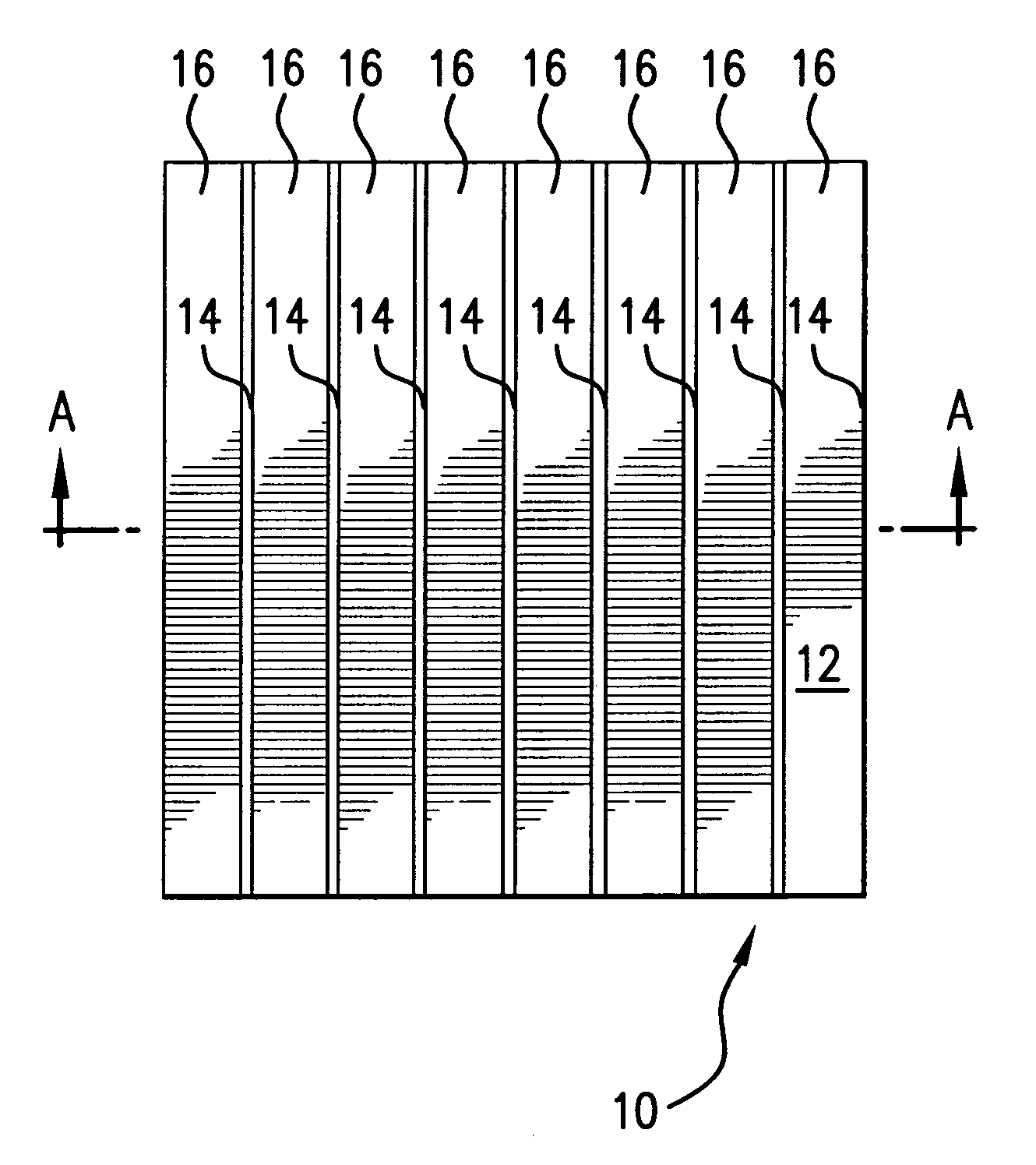[0005] The invention relates to the development of systems and methods that utilize a produce packaging tray for storing and transporting produce. The systems and methods of the invention extend the freshness of and minimize damage to the produce, as well as reduce the risk of
contamination of the produce by airborne agents and other contaminants that cause illness in humans. Because produce is packaged in a single layer within a packaging tray, the systems and methods further provide for consistent, appealing presentation and precision packaging of the produce. The
system of the invention is especially useful for packaging and transporting delicate produce such as squash, zucchini, tomatoes, cucumbers, bell peppers, green beans, jalapeno peppers, peaches, apples, other tree fruit, eggplant, corn, and any vegetables with soft epidermal
layers.
[0006] One example of a produce packaging tray as described herein is a tray having a substantially rectangular and rigid base and a plurality of rigid, uniformly spaced vertical ridges that extend upwards from the base and that are disposed parallel to each other. The ridges are disposed on the base so as to form a plurality of uniformly spaced channels that are each sized to accommodate several pieces of produce which can be disposed longitudinally to each other (i.e., in a head to
tail configuration) within the channel, creating a single layer of produce within the tray. The apex of each
ridge is blunt to prevent damage when the produce is loaded onto the tray. Another example of a produce packaging tray is a semi-rigid, one-piece structure formed by a base having four walls extending therefrom, the tray having a design similar to that of a cookie sheet. Produce that can be packaged using these and other trays described herein include
fruits and vegetables, as well as hybrids thereof.
[0007] A typical method of packaging produce as described herein includes
processing the produce (e.g., washing the produce), positioning the produce into packaging trays such that each tray contains a single layer of produce, and wrapping the produce-containing trays with a wrapping (e.g., a gas permeable plastic wrapping such as
shrink wrap or
plastic wrap) for preserving the safety, quality, freshness, cleanliness, orderliness, as well as the consistent and appealing look of the produce. Wrapping a produce-containing tray with a wrapping also facilitates handling of the tray; handling a plurality of such wrapped, produce-containing trays is easier than handling loosely-packed, bulk produce. After being wrapped, the trays are stacked one on top of the other in a container such as a
cardboard carton for storage and transportation to a wholesaler or retailer. Once the above steps, which are typically performed in a packing facility, are completed, the container(s) containing the produce-containing trays are transported to a retailer, wholesaler, restaurant, or other entity that purchases produce. Although the systems and methods described herein may find particular use by entities that purchase large amounts of produce in bulk, they may also be used by entities or individuals
purchasing smaller amounts of produce.
[0008] Accordingly, the invention features a a method of enhancing the safety and quality of delicate produce to be transported from a packaging facility to a wholesaler or retailer. The method includes the steps of, at a packaging facility: a) washing a plurality of pieces of recently harvested produce; b) positioning a first portion of the plurality of processed pieces of produce into at least a first tray and positioning a second portion of the plurality of processed pieces of produce into at least a second tray; c) wrapping the first portion of the plurality of pieces of produce and the at least first tray with a first piece of material; d) wrapping the second portion of the plurality of pieces of produce and the at least second tray with a second piece of material; e) placing the wrapped first and second trays into a container with the at least second tray stacked on top of the at least first tray; and f) loading the container aboard a vehicle for transport to the wholesaler or retailer. The delicate produce includes squash, zucchini, tomatoes, cucumbers, bell peppers, green beans, jalapeno peppers, peaches, apples, eggplant, and corn. The wholesaler or retailer can be located a distance greater than about 8 kilometers from the packaging facility, and a distance greater than about 804 kilometers from the packaging facility.
[0009] In this method, the at least first and second trays each include a semi-
rigid structure formed by a base and a plurality of semi-rigid, uniformly spaced vertical ridges that each extend upwards from the base and that are disposed parallel to each other, the ridges disposed on the base to form a plurality of uniformly spaced channels that are each sized to accommodate at least two pieces of produce for storage and / or transport, the apex of each
ridge being blunt. The step (b) of positioning a first portion of the plurality of pieces of produce into at least a first tray and positioning a second portion of the plurality of pieces of produce into at least a second tray includes positioning each piece of produce such that the first portion of the plurality of pieces of produce are disposed longitudinally to each other in the at least first tray and the second portion of the plurality of pieces of produce are disposed longitudinally to each other in the at least second tray. The first piece of material can be
moisture impermeable,
moisture permeable, gas permeable, and gas impermeable. The wrapped first tray can include a gas that modulates
ripening of the produce. The at least first and second trays can each have a tab operably coupled thereto for facilitating lifting of the at least first and second trays from the container.
 Login to View More
Login to View More  Login to View More
Login to View More 


